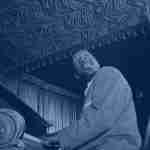Jazz scales are something everyone talks about. Chances are, you’ve been told that you need to know dozens of scales to play jazz and that these structures hold the keys to unlocking jazz improvisation.
But what you might not realize is that you don’t need to know a million jazz scales to construct a solid jazz solo and that some are more important than others.
So today, we’re going to get into everything you need to know about jazz scales…
- What scales are and why they matter
- Where jazz has completely gone wrong with scales
- Which scales you need to know and why
- What modes are and how they confuse everything
And specifically, throughout this lesson on jazz scales, will get into the Major Scale Modes, The Most Useful Bebop Scales, the Melodic Minor Scale Modes, The Diminished Scale, and The Whole Tone Scale…
But first, let’s start off by talking a little bit about what scales actually are…
What Are Scales?
I’m sure you are familiar with scales, but have you ever thought about what a scale actually is?
Just like a chord or an arpeggio, a scale is just a collection of intervals, but where they differ is in the specific intervals that they typically contain.
You see, jazz harmony is based upon tertiary harmony, which is just a fancy way of saying stacked thirds.
So, chords, which are the absolute essential piece of harmony, are simply structures of stacked thirds, both major thirds & minor thirds…
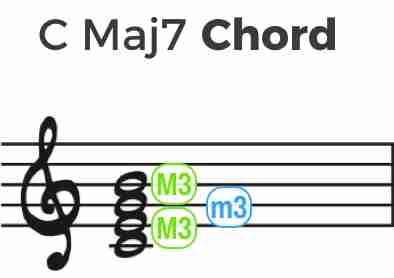
And an arpeggio is when the notes of a chord are played one after another instead of simultaneously.

But scales, as in the Major Scale below, in general, are comprised of mostly the two smallest intervals, whole-steps and half-steps, also called major seconds and minor seconds.

Now there are certainly scales that use intervals besides these two, but the important things to note here are:
- A scale is typically not considered a structure of stacked 3rds. That would be a chord or an arpeggio.
- The essential jazz scales tend to use mostly whole-steps & half-steps
- The notes of a scale are played one after another
So now that you know what a scale is and how it differs from a chord or an arpeggio, let’s talk about where jazz education went wrong with them…
Jazz Scales: Where Jazz Education Went Wrong
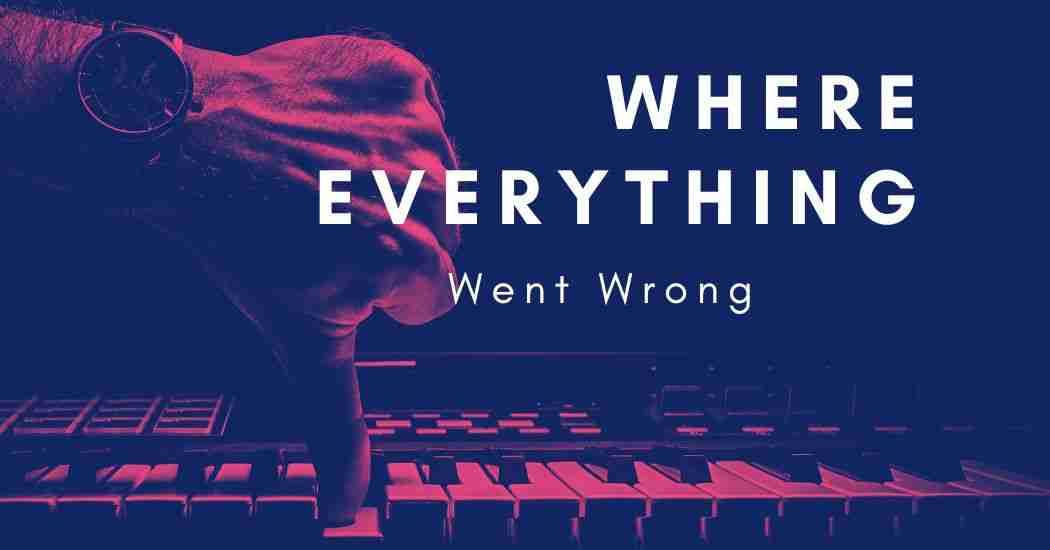
Years ago, jazz educators started to become enthralled with Modal Jazz and George Russell’s famous book The Lydian Chromatic Concept of Tonal Organization..
And using this modal thinking, they thought about how they might construct a model for teaching and playing jazz improvisation.
Gradually, they developed a new scale-based system to approach chords and progressions that could help beginners improvise without knowing much.
And for better or worse, this scalar system has become the primary way to teach and play jazz today…
The Chord-Scale System & Jazz Scales
This model is loosely referred to as The Chord-Scale System and the whole idea is that for each chord in a tune, you can apply specific scale(s) known as scale choices.
And, you might be surprised to hear me say this, but the model has some major benefits…
- It allows a beginner mental access to consonant notes of a chord without understanding the chord structure or the chord-tones at all
- It allows a beginner to play over a group of chords, a progression, without understanding chord function & harmony
- It allows a beginner to play mostly consonant notes in their solo with very limited knowledge of the jazz language
So the model can get a beginner playing rather quickly without knowing much of anything…
But the problem is, there are some major shortcomings to the model…
The BIG FLAW in the model with jazz scales
Here’s the thing…
With the adoption of the Chord-Scale Model, jazz education lost the whole point of what it actually means to improvise jazz, and instead turned it into a series of mental calculations & random guesswork…
Get the idea out of your head that you’re applying scales to each chord and that jazz improvisation is a series of switching scales and mixing up the notes. It’s NOTHING of the sort.
Applying scales to chords and mixing up the notes is equivalent to a paint-by-number approach, and is not at all the point of jazz improvisation…
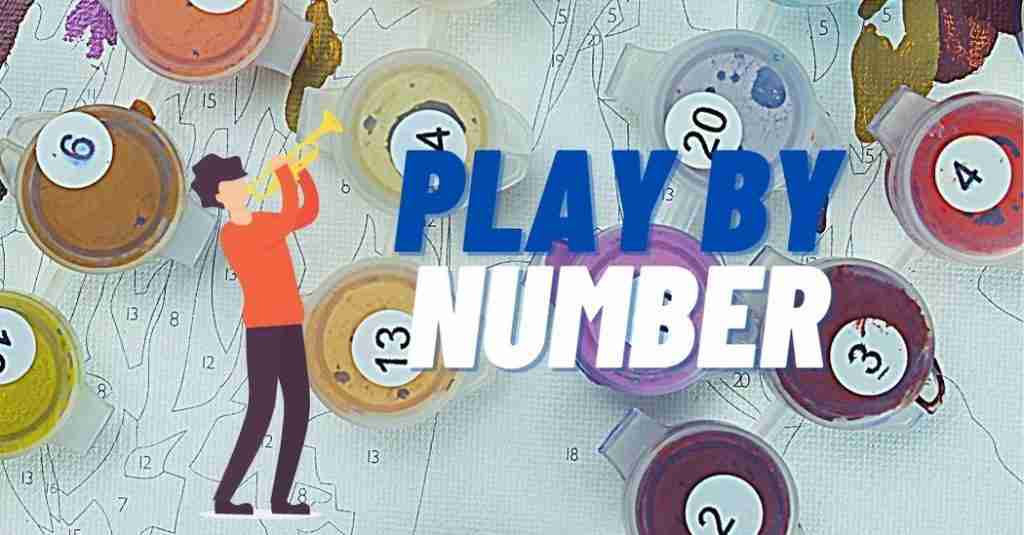
So what is?
The whole point can be boiled down to this…
- Learn to hear in your mind what it is you want to play
- Then learn to play what you hear in your mind in real-time
And a good analogy for this is that when you’re taking a solo, it’s as if there’s a radio playing in your head with the melodic lines that you wish to play…
You intently listen to this radio inside your mind and you selectively play what you hear in your head, on your instrument in real-time.

Now, obviously, to develop this ability takes time and work, but remember…it’s the ultimate goal that you want everything you practice to bring you closer to.
So how do you get there??
You get there through the process of studying everything we talk about all the time…
- Transcribing your favorite solos
- Training your ear as much as you can
- Acquiring Jazz language and Melodic Techniques
- Understanding jazz Harmony and music theory
- Studying the jazz standard repertoire
All of these activities fuel the radio in your mind with things you want to play, and help you connect your ears and fingers to what you hear.

But to do all of this effectively, you need all the basic musical structures like intervals, chords, chord arpeggios, and scales, ingrained in your ear, mind, and fingers at a deep level.
So scales are not bad…
They’re actually very important and worthwhile, as long as you understand that they are NOT the only tool you use to improvise.
They are part of your base-layer of understanding and there is much to learn beyond them if you want to solo in the vein of your heroes.
What Are Jazz Scales Actually Good For?
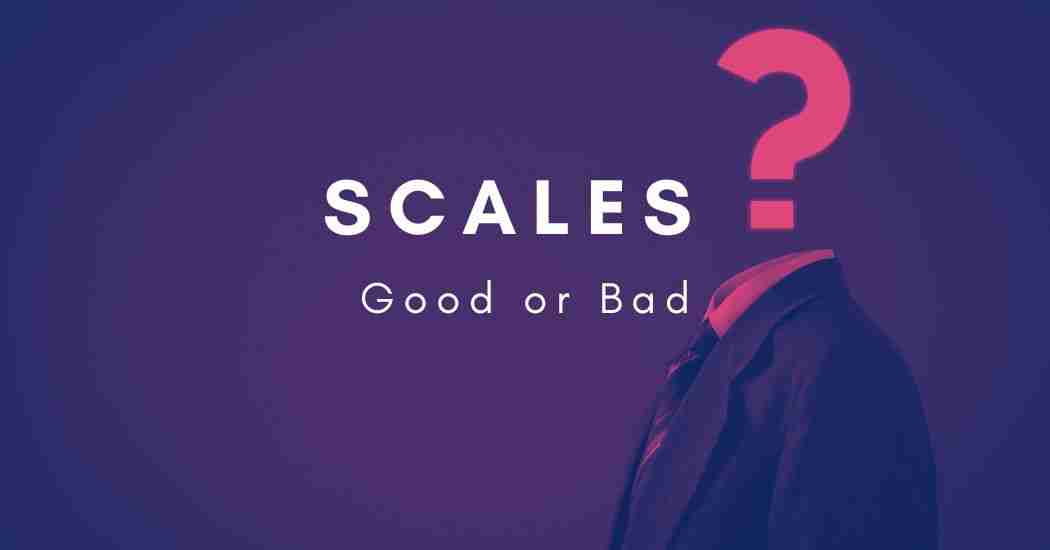
We spend a lot of time reminding you that scales are not the secret shortcut to jazz, that they’re just a small piece of the picture and that if you’re not careful with them, they’ll steer you in the wrong direction.
So what are they actually good for?
What scales are good for
Practicing scales for jazz will benefit you in several ways:
- Technique – By practicing scales, you’ll improve your instrumental technique, smooth out your fingerings, and improve your physical connection to your instrument.
- Linear Chord Understanding – Learning scales helps you view a vertical chordal structure up to the 13th (1-3-5-7-9-11-13) as a linear scalar structure (1-2/9-3-4/11-5-6/13-7), giving you an alternate perspective to a chord.
- A Reference Point – You have to start somewhere. A scale gives you a reference point to build from, for example knowing a C Major Scale, gives you the ability to understand a C7 chord and scale by lowering the 7th.
- Hearing Jazz Language – Scalar runs are present throughout the jazz language. When you’ve studied scales, you can easily hear these runs, quickly transcribe them and use them in your own playing
What scales are NOT good for?
- They’re NOT a Great Melodic Device – When you take a solo, you are not mixing up notes from a scale. You’re informed by the scale, but you’re soloing is based more upon jazz language, melodic soloing concepts, and using your ear
- They’re NOT a Substitute For Understanding Chords – When you know the chord-tones within a chord and how they sound, you realize that they are not melodically equal. Using scales without this knowledge results in melodic lines that sound weak, illogical, and boring.
- They’re NOT a Substitute for Learning Harmony – Applying scales rather than understanding harmony and chord function will always leave you in the dark. You have to understand each chord’s purpose and how it fits into the larger story of the tune’s harmonic progression.
Remember, knowledge of a chord and scale is the absolute base layer of information for when you go to solo.
Keep these points in mind when you learn scales so that you don’t fall into the common trap, thinking that scales are how you actually improvise.
What are The Essential Jazz Scales?
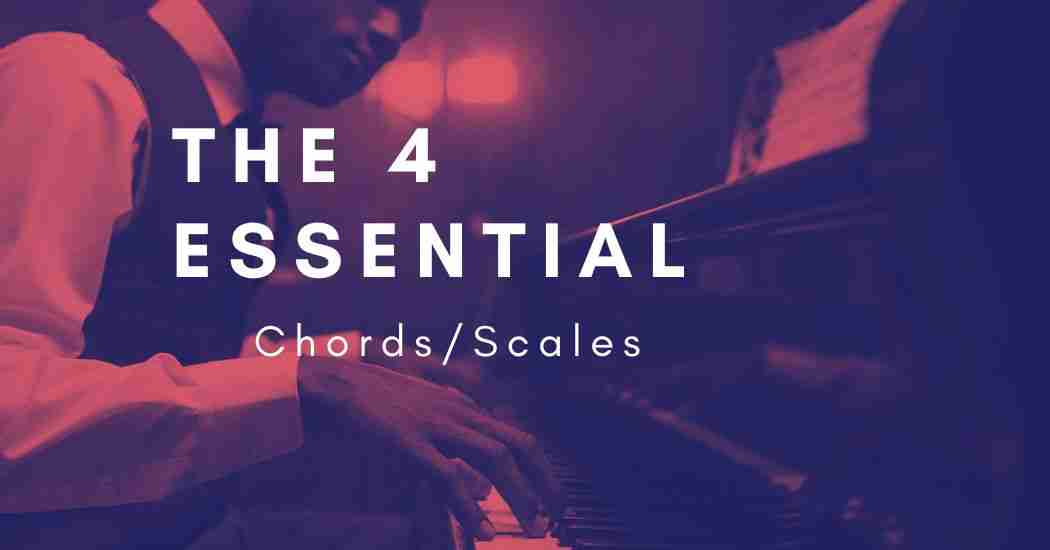
Jazz Scales are the specific scales that jazz education includes in their Chord-Scale Jazz Theory Model.
And this includes quite a few scales…
- Major Scales and modes (7 scales)
- Melodic Minor Scales and modes (7 scales)
- The Diminished Scale
- The Whole tone scale
- And possibly more…
That’s a total of at least 16 scale types, which doesn’t seem like that much, but in all twelve keys becomes almost 200 scales…
That’s a TON of scales!
But here’s the thing…some of these are more important than others, and moreover, there are some very helpful scales besides these 16…
So let’s talk about this…
The Essential 4 Jazz Scales
In this lesson, we’ll explore many of the scales people talk about so you have a complete picture of jazz scales and all the info at your disposal…
But before we do, I want to emphasize to you that the Chord-Scale Model is overkill for most situations, especially for beginners.
There are only 4 chord types that make up most of what you encounter in jazz, so why do you need to memorize a million scales right away?
You see, in jazz standards, there are 4 Basic Chord Types:
- Major
- Minor
- Dominant
- Half Diminished
And each of these chords corresponds to a specific mode of the Major Scale, for example, we can find the chord C Major functioning as the I chord in the key of C Major, which is the C Ionian Mode…

Or if we want C minor, it functions as the ii chord in Bb major, and the mode is called C Dorian (Keep in mind that minor chords function other ways too)…

If we’re looking for C7, it functions as the V7 chord in the key of F Major, C Mixolydian…

And we can find C Half Diminished as the 7th chord in Db Major, C Locrian (And understand how it functions in a minor key as well)…
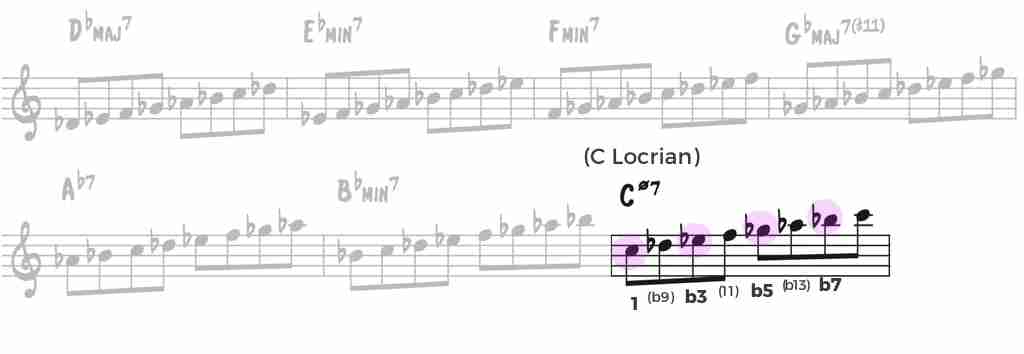
But remember that these 4 modes are not some separate esoteric concept that you’re applying to a chord – they ARE the chord (1-3-5-7-9-11-13), rearranged into a linear structure, a scale (1-2/9-3-4/11-5-6/13-7).

So that’s the thing…
Each of these modes is just a linear view of the chord and if you understand chord function, then it’s very easy to see where each chord/mode comes from and what chord-tones it contains.
So rather than learning every single scale possible right away, first work on these 4 and make sure you have fluidity with them.
The Major Scale and its Modes
Okay, so at this point you know what scales are, why they’re important, what they’re used for and not used for, and that 4 scales correspond to the 4 chord types that you encounter over and over…
And, most importantly, you understand that these scales are not actually any different from the chord – that they’re a linear view of a vertical structure.
But of course, understanding all the Major Scale Modes, will help give you a more complete picture…
Here are all of the Modes of the Major Scale and the chords that they represent.
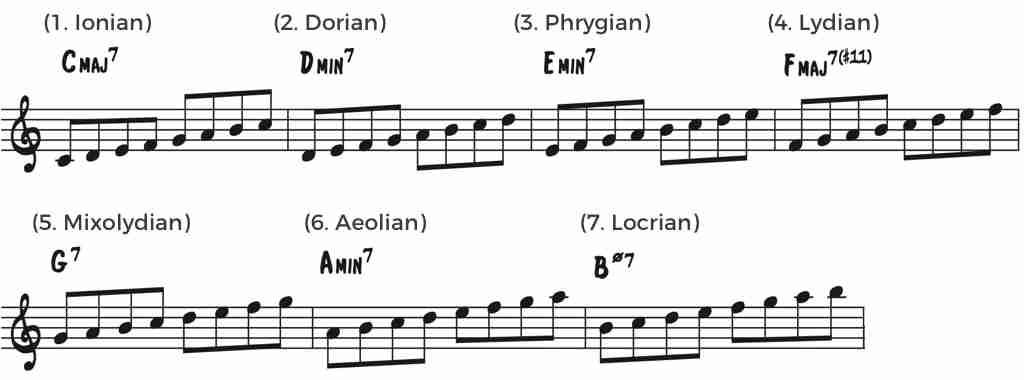
It’s important to understand here that Major Harmony is functional, meaning each chord behaves a specific way within the key and that the major scale modes are simply a linear view of each of these functional chords.
Below I’ve labeled each of the chord-tones of each mode in relation to the Major Scale (that’s the reference point I’m using)…
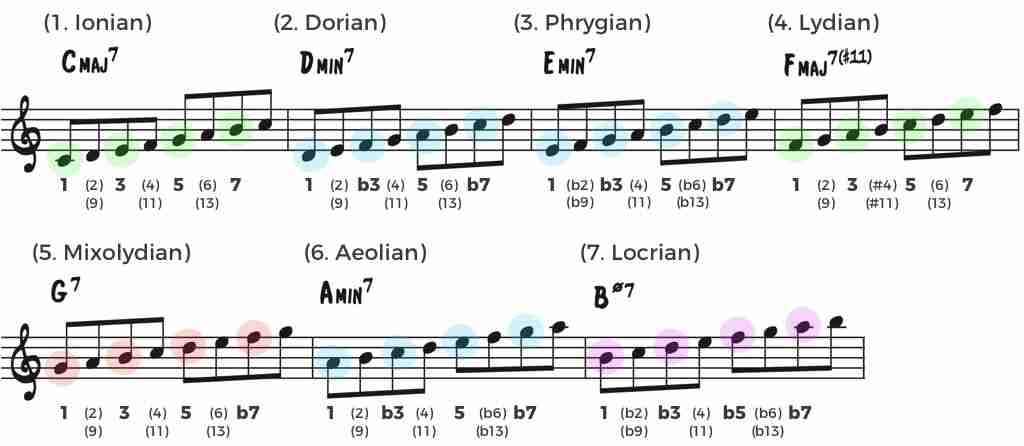
You can easily see here how the modes of the Major Scale precisely represent the chord and how each corresponds to how the chord is functioning:
- Ionian – Tonic Major Chords
- Dorian – Minor Chords functioning as ii minor
- Phrygian – Minor Chords functioning as iii minor
- Lydian – Major Chords functioning as IV major
- Mixolydian – Dominant Chords functioning as V7
- Aeolian – Minor Chords functioning as Vi minor
- Locrian – Half Diminished Chords functioning as Vii-7b5, or ii-7b5 in a minor key
Not all scales that jazz education uses today are functional, which is why they are so problematic and confusing.
But when it comes to Major & Minor Harmony, all of the modes are a scalar view of the chord that functions from that position, which is knowledge you can thoroughly master in our Jazz Theory Course.

Okay, now let’s look at some specific Bebop Scales that can transform some of the Major Scale modes into useful melodic devices…
Useful Bebop Scales
Normal scales, like the modes of the Major Scale, have one very big fault melodically – they don’t automatically put the strong chord tones like 1-3-5-7 on the strong downbeats of the measure…
So, without some jazz language and harmonic understanding, using one of these normal scales as a melodic device will often sound as if you’re just mixing up random notes, instead of creating defined melodic lines with direction and purpose…
A quick fix for this is to learn how to use Bebop Scales – scales that have an extra note inserted in just the right spot to ensure that the right chord tones land on the strong downbeats.
Here are some of the most useful Bebop Scales that will help you immensely…
The Bebop Major Scale
The Bebop Major Scale inserts an extra note between the 5th and 6th notes of the standard Major Scale, putting 1-3-5-6 on the downbeats.

The Bebop Dominant Scale
The Bebop Dominant Scale inserts an extra note between the 7th and Root notes of the standard Mixolydian Scale, putting 1-3-5-b7 on the downbeats.

The Bebop Dominant b9 Scale
This super useful scale, which I call the Bebop Dominant b9 Scale, sounds great when you want to play over a dominant chord with a b9 sound…
And like the Bebop Dominant Scale, it has an extra note inserted between the 7th and the Root, and puts 1-3-5-b7 on the downbeats, but in addition it includes the b9 & b6/b13 within the scale.

To master Bebop Scales, make sure to check out this lesson on Everything You’ve Ever Wanted to Know About The Bebop Scale But Were Afraid To Ask.
Bebop Scales are highly prevalent in the playing of your heroes, so make sure you take the time to get them under your fingers and in your ears.
Melodic Minor Scales & Modes
Okay, we’ve covered The Major Scale and its modes, along with 3 very useful Bebop Scales…
Now we’ll start talking about scales that are a bit more esoteric.
The Melodic Minor Scale is a unique minor scale that contains a minor 3rd and a major 7th.
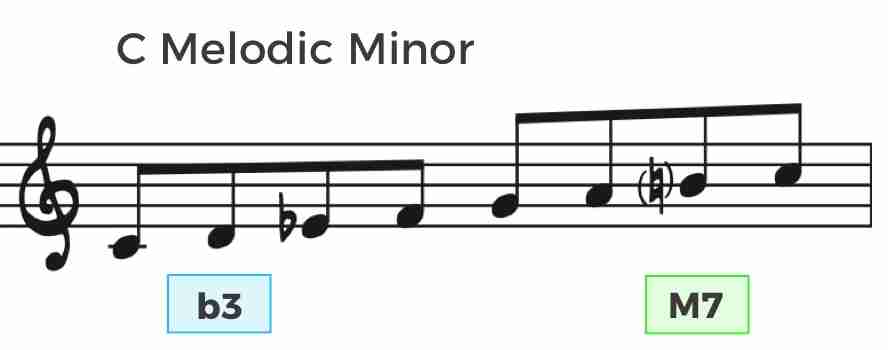
When you look at the 7 modes of Melodic Minor, you end up with some pretty interesting (and kind of bizarre) chord types.
I’ve kept the C Melodic Minor scale intact throughout so you can see how the modes express each chord…
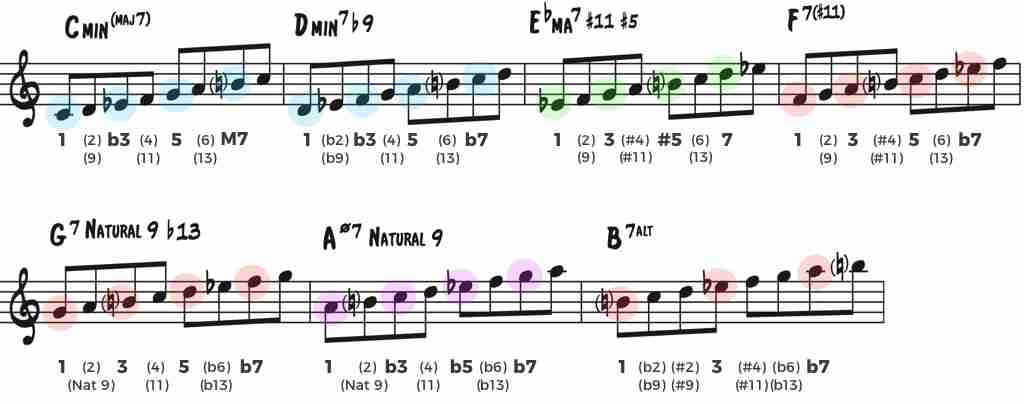
Now, while many people today think that Melodic Minor scales and modes are absolutely essential, I tend to veer away from popular opinion here…
Melodic Minor is not as crucial as you think
I like to think of Melodic Minor scales and modes as the icing-on-the-cake…
They’re an advanced concept that’s quite difficult to make use of until you have a solid foundation in jazz harmony and a working knowledge of jazz language.
And please don’t make the mistake here that advanced means better…
In fact, only a small amount of what you’ll find in the transcriptions of your heroes touches on concepts from Melodic Minor…
So, rather than drowning in Melodic Minor scales and modes, and adding a ton of confusion into the mix, instead build a solid foundation with:
- The 4 Essential Chords and Scales
- All of Major Harmony and modes
- Altered Dominant Chords
Then, if you have the burning desire to to add this modern layer of interest to your soloing concept, check out this detailed lesson on Melodic Minor.
Again, despite everything you’ve heard, Melodic Minor is a very modern concept and, in my opinion, something you should only add in much later in your development once you have a handle on the fundamentals.
The Diminished Scale
Now, like the Altered Scale from the Melodic Minor modes, another tactic on dominant chords uses the Diminished Scale…
And the Diminished Scale can be a great addition to your musical toolbox, if used correctly…
It has two forms, both comprised of alternating whole and half-steps. The first is called the Half-Whole Diminished Scale because it starts with a half-step and is followed by a whole-step…

And the other is called the Whole-Half Diminished Scale because it begins with a whole-step and then is followed with a half-step…

In reality, they’re the same scale, just starting on a different note…in other words, the G Half-Whole is the same as Ab Whole-Half…

And the G Whole-Half is the same as A Half-Whole…

So they’re just two different perspectives of the same information in a way.
Now most of the time, the Diminished Scale (half-whole) is used over a dominant chord to imply a V7 dominant sound, that contains a b9, a #11 , and a natural 13…
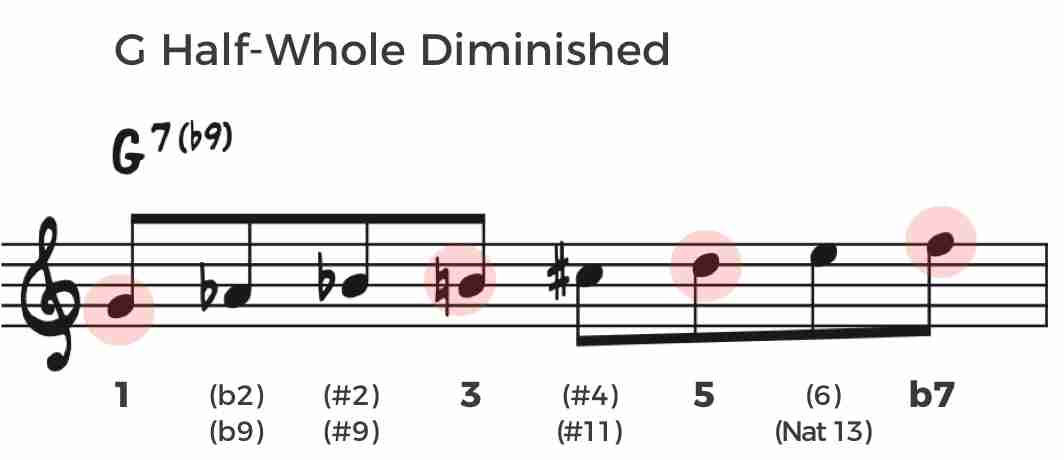
To master Diminished Chords and Scales check out these lessons:
Diminished chords and scales are actually pretty tricky to understand in terms of harmony. For a complete framework of how they work, start our Jazz Theory Unlocked Course…

The Whole Tone Scale
One final scale we’ll quickly talk about is quite interesting…
The Whole-Tone Scale is a 6 note scale comprised of all whole-steps, major seconds…
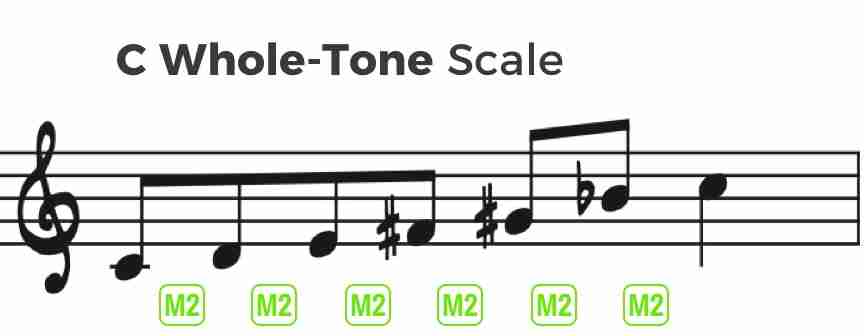
And if you look closely, you’ll realize that the notes of this scale imply a V7 Dominant chord with a #4/#11, a #5, and a natural 9th.

The key here is the natural 9th in combination with the alterations, the #4/#11 and #5.
When the 9th remains in its natural state, but the other alterations are included, you end up with quite a unique sound.
Jazz Scales: What You Need To Know
As you now know, there are quite a few scales that jazz musicians make use of…but there’s no need to go crazy trying to memorize dozens of scales in all keys.
Here’s a diagram that sums up all the scales we talked about today, showing you the most essential on the bottom, leading to the least essential on the top…

So start with the 4 most essential chord types: Major, Minor, Dominant, and Half Diminished. These are your baseline chords and scales – reference points that make everything much easier.
Then gradually, add the other jazz scales layers on top.
Most importantly, remember some of the finer details we went over today…
- What scales are actually good for
- What they’re NOT good for
- Where Jazz Theory has gone wrong with scales
- The whole point of what it is you’re trying to do when soloing
- Why you should start with the essential 4 scales/modes
- Why chord function matters so much
- Why Melodic Minor doesn’t matter as much as you think
And that’s just some of what we discussed!
As you can see, there’s a lot to understand when it comes to jazz scales – you’re not just memorizing a bunch of scales and mixing up the notes…that’s what you’re trying to steer clear of…
And if you’ve understood that today, then you’re avoiding years of frustration and setting yourself up for success.
With everything we went over today, you can now confidently take your fluency with jazz scales to a new level, giving you yet another powerful tool to add to your jazz improvisation approach.









